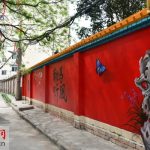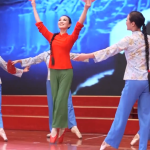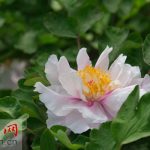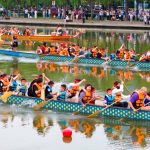
Stone carvings of Yiyang County in Qing Dynasty (file picture)
Ninety miles west of Yiyang City, there are a few famous women in a majestic mountain. These women’s mountains are considered by many people today to be the “past life” of Huaguo Mountain, or rather, they are the two names of a mountain. However, Zheng Zhenfu, an expert in the city’s literature and history, believes that the two cannot be completely confused, and the scope of Nuji Mountain includes the highlands in the north in addition to today’s Huaguo Mountain Scenic Area.
The women who came from the ancient legends are full of fairy spirit and humanities, like a woman with a bewitching appearance and a rich heart. For you and me, such a mountain may have a more unique charm that is hard to resist.
A mountain is majestic and famous women
Nuji Mountain is the remnant vein of Bear’s Ear Mountain, located in the southwest of Yiyang County, about 90 kilometers away from Luoyang City. It is a historic mountain with many ancient legends. However, today’s people think that what they have experienced is the scenery of Huaguo Mountain, and the Nuji Mountain seems to be just the “past life” of Huaguo Mountain, which is only alive in the pen of literati and writers of the past dynasties.
A few days ago, when I learned that I was going to visit Nuji Mountain, Zheng Zhenfu, an expert in literature and history of the city, specially reminded: “Now people generally think that Nuji Mountain is Huaguo Mountain, but in fact, the two are not exactly the same. In addition to the current Huaguo Mountain Scenic Area, the range of Nuji Mountain also includes the highlands in the north. ”
I see. I can’t wait to see the true face of Nüji Mountain, because just from the name, it is full of fairy energy, and with so many ancient legends, it will definitely be interesting.
The record of Nuji Mountain is in the earliest geography book “Classic of Mountains and Seas” in China: “Nuji Mountain…… Luoshui comes out of Yan, and the east is injected into the river. Some people may find it strange: how did you get such a chic name as Nujishan? There are many legends in it. One said that the fairy orchid became an immortal in this mountain, and its ascension to the immortal left a stone few, so the name of the female several mountains; It is said that Peng E, a Jin woman, touched the cliff and died after encountering robbers, and the drawer she carried turned into this mountain, so it was called the female Ji (several) mountain; One said that the female couple was a woman who sold wine, “making wine is often beautiful, the immortals drank at their homes, and the wine money was made in five volumes of plain books, and it was the art of immortality to open their eyes”, so they practiced hard in this mountain and became an immortal, leaving the name of the female several mountains……
During the Northern Wei Dynasty, Li Daoyuan wrote “Notes on the Book of Water”, saying that Nujishan is also known as Huagu Mountain, which was transformed after the death of Gu Yao, the daughter of the Yellow Emperor. In the early years of the Northern Song Dynasty, the name of Huaguo Mountain began to appear in the “Taiping Huanyu Ji”, one said that it was the false name of Huagu Mountain, and the other said that its name was because the mountain was beautiful and had many strange flowers and fruits.
Nowadays, most of the cultural attractions in Huaguo Mountain are related to “Journey to the West”, and the literati and writers of all dynasties admired this mountain. For example, Shao Yong in the Song Dynasty has a poem “Looking at the Girl and Several Mountains”, saying that “there are many mountains to see, and I have not tasted this strangeness”; Tang Bohu, the “first merry genius in the south of the Yangtze River” in the Ming Dynasty, lingered here and left many famous works such as “Spring Girl Traveling to Several Mountains”; The famous “Neon Clothes and Feather Song” is said to have been inspired by Tang Xuanzong’s sleepwalking female mountains.
The female mountain people are poor because of poetry
However, although there are many celebrities who go to Nüjishan to chant, they are all passers-by after all. We have reason to believe that those who were born, grew up, and sang and cried in Si will have a deeper affection for Nujishan, such as the hard wishes of the Jin Dynasty.
Xin Yuan Zi Jingzhi, No. Xinan Poetry Lao, self-proclaimed female savage, died in 1231, the year of birth is no longer available. His ancestral home is Fengxiang, Shaanxi, and later moved to Nujishan with his grandfather, where he farmed for a living. At the age of 25, he began to aspire to study, working in the mountains during the day and returning to the hut at night to write poems. Yuan Haowen admired Xin Yuan very much, calling his poems “good sentences really worthy of praise”, and cited him as one of the “three confidants”.
Some people may ask: Xin Yuan has never been a farmer in the mountains in his life, how did he become a confidant with the famous Yuan Haowen? This has to start with the Mongol invasion of the Central Plains. In 1216, the Mongols rode to Xiurong (now Xin County, Shanxi) in Xinzhou, and the 27-year-old Yuan Haowen had to leave his hometown to avoid the war, and came to Yiyang Sanxiang with his mother, and then lived in the foothills of Nuji Mountain for several years. During this time, he became close friends with Xin Yuan, and at the same time made friends with domestic celebrities Ma Ge and female Qiao Liu Angxiao.
These celebrities in the poetry world drank poems and drank in Nujishan and had a good time. Yuan Hao asked the poem “Question Mountain Pavilion Drinking Map”: “A few female woodcutters stuffed words, and Xinan Laozi sat in the middle of the poem.” Because Jun evokes the dream of the mountain pavilion, it is like when the three towns are drunk together. This poem is a reminiscence of the past when everyone gathered. And the work “Thirty Quatrains of Poetry”, which established his status in the literary world, was also written when he lived in Sanxiang.
Born in troubled times, good times are always fleeting. Friends were quickly separated, and with the hard work of celebrities and heroes, it was difficult to continue even the days of Mai straw sandals. As he wrote in the poem “After the Chaos”: “The soldiers go to the people and return to the sun, and the flowers bloom in the snowy sky.” The grass in the wilderness of the river, and the new smoke in the ruins. Sleepy rats chirp on the empty wall, and hungry birds peck at the wasted fields. It seems that people are talking chaotically, and the county officials have urged money. “His situation is so sad, and even more unfortunate is yet to come. On a bitterly cold winter day, the county official who came to “urge money” overturned his bamboo basket, which contained his life’s work! Xin Yuan was saddened and watched more than 1,000 poems be destroyed, and in the end only more than 20 were preserved.
When Yuan Haowen saw Xin Yuan again, he almost didn’t recognize this down-and-out old man, and he was busy bringing out food to satisfy his friend’s hunger. Xin Yuan raised the basket but did not eat, and said, “I have never eaten a full meal in my life.” If you have enough to eat today, why waste food tomorrow? In 1231, the poet, who had been with Nujishan all his life, died of hunger and cold in Yiyang Road.
Who doesn’t admire idle clouds here
Last Thursday, I set off from Luoyang New District, followed the Luoyi Expressway to Yiyang County, and then southwest, and it took me about two hours to reach Huaguo Mountain. When you get here, you can count it as a woman’s mountain. Along the way, what I thought about the most was the legend of Nuji Mountain, I can’t wait to fly to the top of the peak with wings, a glimpse of the fairy mountain, if you are lucky, you may be able to find the relics left by the immortals.
However, I was too late to make it: the mountain had just snowed and the road was icy, and the mountain had already been closed. Wang Zhenwu, the person in charge of Huaguoshan Scenic Area, looked at my eagerness and said: “To see the whole picture of the mountain, get the top of the mountain, there is a Huashan Temple on the top of the mountain, which is a building in the Tang Dynasty and was built around 800 AD. However, there are 12 kilometers from the gate here to Huashan Temple, only 4 kilometers can be walked by car, and the remaining 8 kilometers of icy roads have to be walked all by walking. ”
Come all the way, is it just a trip in vain? I was unwilling. Wang Zhenwu thought of a way: “That’s it, you can still drive on the road just entering the mountain, you go up and have a look first.” There’s also a nice vantage point a little further down the hill where you can see the whole mountain, and I’ll take you there later. ”
I did as I was told. The car spirals up the steep mountain road, and before you can enjoy the beautiful scenery, you reach the snow-covered section. The rocks and trees here are still colorful, but the waterhole in front of the nearby water curtain cave is frozen, and the air is so clear that you can’t help but shiver.
Due to the narrowness of the valley, the peaks seen by people in the mountains are all local, let alone the highest peak at 1831.8 meters above sea level. Despite this, I already feel that as Shao Yong said, this mountain is quiet and beautiful, which is not something that Danqing can describe. It would be nice if you could linger here all day long like Xianyun! Unfortunately, I can’t, it’s not too early to see the time, so I have to go down the mountain as soon as possible to find another viewpoint.
Turning right on a highway out of the scenic area, Wang Zhenwu told me that this place is located in Huaguoshan Township (formerly Muxi Township), and there are more than 800 villagers in Huashan Village on the mountain, and they live very scattered. “The temples on the mountain and the homes of the villagers mostly worship the monkey-faced Monkey King. The villagers can also tell a lot about the legend of Nüji Mountain. He said.
Walking along the highway for about 7 kilometers, we parked on the side of the road, looked back at the Nuji Mountain, only to see the peaks and peaks, the layers are clear, especially a section of the mountain like a sleeping beauty lying there, looking back to the sky, looking peaceful. Wang Zhenwu said that it was the Goddess Peak, and if the angle was chosen well, it would look more realistic.
Really? Phantom? Somehow, after seeing the Goddess Peak, all kinds of legends about the Nuji Mountain seem to have solid “roots”. I think I will come again at the right time and read this fairy mountain with my heart. (Reporter Zhang Guangying, text/photo)








